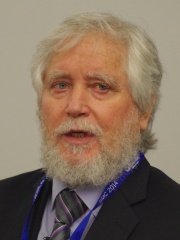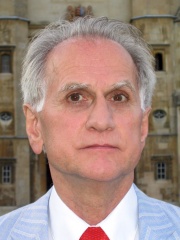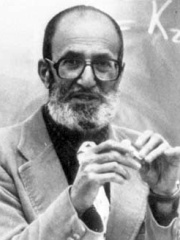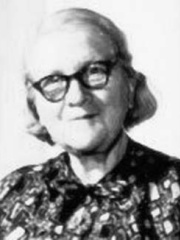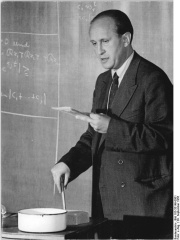
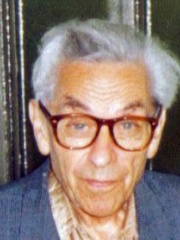
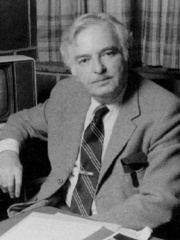

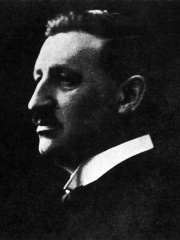
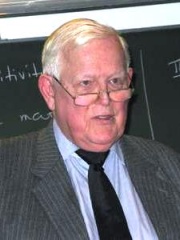
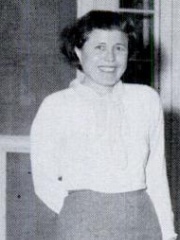
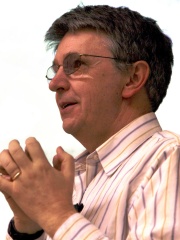
The Most Famous
MATHEMATICIANS from Hungary
This page contains a list of the greatest Hungarian Mathematicians. The pantheon dataset contains 1,004 Mathematicians, 24 of which were born in Hungary. This makes Hungary the birth place of the 9th most number of Mathematicians behind Poland, and Ukraine.
Top 10
The following people are considered by Pantheon to be the top 10 most legendary Hungarian Mathematicians of all time. This list of famous Hungarian Mathematicians is sorted by HPI (Historical Popularity Index), a metric that aggregates information on a biography's online popularity. Visit the rankings page to view the entire list of Hungarian Mathematicians.

1. John von Neumann (1903 - 1957)
With an HPI of 79.93, John von Neumann is the most famous Hungarian Mathematician. His biography has been translated into 98 different languages on wikipedia.
John von Neumann ( von NOY-mən; Hungarian: Neumann János Lajos [ˈnɒjmɒn ˈjaːnoʃ ˈlɒjoʃ]; December 28, 1903 – February 8, 1957) was a Hungarian and American mathematician, physicist, computer scientist and engineer. Von Neumann had perhaps the widest coverage of any mathematician of his time, integrating pure and applied sciences and making major contributions to many fields, including mathematics, physics, economics, computing, and statistics. He was a pioneer in building the mathematical framework of quantum physics, in the development of functional analysis, and in game theory, introducing or codifying concepts including cellular automata, the universal constructor and the digital computer. His analysis of the structure of self-replication preceded the discovery of the structure of DNA. During World War II, von Neumann worked on the Manhattan Project. He developed the mathematical models behind the explosive lenses used in the implosion-type nuclear weapon. Before and after the war, he consulted for many organizations including the Office of Scientific Research and Development, the Army's Ballistic Research Laboratory, the Armed Forces Special Weapons Project and the Oak Ridge National Laboratory. At the peak of his influence in the 1950s, he chaired a number of Defense Department committees including the Strategic Missile Evaluation Committee and the ICBM Scientific Advisory Committee. He was also a member of the influential Atomic Energy Commission in charge of all atomic energy development in the country. He played a key role alongside Bernard Schriever and Trevor Gardner in the design and development of the United States' first ICBM programs. At that time he was considered the nation's foremost expert on nuclear weaponry and the leading defense scientist at the U.S. Department of Defense. Von Neumann's contributions and intellectual ability drew praise from colleagues in physics, mathematics, and beyond. His accolades include a Medal of Freedom and a crater on the Moon named in his honor.

2. Paul Erdős (1913 - 1996)
With an HPI of 72.17, Paul Erdős is the 2nd most famous Hungarian Mathematician. His biography has been translated into 68 different languages.
Paul Erdős (Hungarian: Erdős Pál [ˈɛrdøːʃ ˈpaːl]; 26 March 1913 – 20 September 1996) was a Hungarian mathematician. He was one of the most prolific mathematicians and producers of mathematical conjectures of the 20th century. Erdős pursued and proposed problems in discrete mathematics, graph theory, number theory, mathematical analysis, approximation theory, set theory, and probability theory. Much of his work centered on discrete mathematics, cracking many previously unsolved problems in the field. He championed and contributed to Ramsey theory, which studies the conditions in which order necessarily appears. Overall, his work leaned towards solving previously open problems, rather than developing or exploring new areas of mathematics. Erdős published around 1,500 mathematical papers during his lifetime, a figure that remains unsurpassed. He was known both for his social practice of mathematics, working with more than 500 collaborators, and for his eccentric lifestyle; Time magazine called him "The Oddball's Oddball". He firmly believed mathematics to be a social activity, living an itinerant lifestyle with the sole purpose of writing mathematical papers with other mathematicians. He devoted his waking hours to mathematics, even into his later years; he died at a mathematics conference in Warsaw in 1996. Erdős's prolific output with co-authors prompted the creation of the Erdős number, the number of steps in the shortest path between a mathematician and Erdős in terms of co-authorships.

3. John G. Kemeny (1926 - 1992)
With an HPI of 69.16, John G. Kemeny is the 3rd most famous Hungarian Mathematician. His biography has been translated into 36 different languages.
John George Kemeny (born Kemény János György; May 31, 1926 – December 26, 1992) was a Hungarian-born American mathematician, computer scientist, and educator best known for co-developing the BASIC programming language in 1964 with Thomas E. Kurtz. Kemeny served as the 13th President of Dartmouth College from 1970 to 1981 and pioneered the use of computers in college education. Kemeny chaired the presidential commission that investigated the Three Mile Island accident in 1979. According to György Marx he was one of "The Martians".

4. George Pólya (1887 - 1985)
With an HPI of 69.06, George Pólya is the 4th most famous Hungarian Mathematician. Her biography has been translated into 42 different languages.
George Pólya (; Hungarian: Pólya György [ˈpoːjɒ ˈɟørɟ]; December 13, 1887 – September 7, 1985) was a Hungarian-American mathematician. He was a professor of mathematics from 1914 to 1940 at ETH Zürich and from 1940 to 1953 at Stanford University. He made fundamental contributions to combinatorics, number theory, numerical analysis and probability theory. He is also noted for his work in heuristics and mathematics education. He has been described as one of The Martians, an informal category which included one of his most famous students at ETH Zurich, John von Neumann.
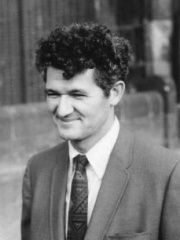
5. Peter Lax (1926 - 2025)
With an HPI of 68.72, Peter Lax is the 5th most famous Hungarian Mathematician. His biography has been translated into 37 different languages.
Peter David Lax (1 May 1926 – 16 May 2025) was a Hungarian-born American mathematician and Abel Prize laureate working in the areas of pure and applied mathematics. Lax made important contributions to integrable systems, fluid dynamics and shock waves, solitonic physics, hyperbolic conservation laws, and mathematical and scientific computing, among other fields. In a 1958 paper Lax stated a conjecture about matrix representations for third order hyperbolic polynomials which remained unproven for over four decades. Interest in the "Lax conjecture" grew as mathematicians working in several different areas recognized the importance of its implications in their field, until it was finally proven to be true in 2003.

6. Marcel Grossmann (1878 - 1936)
With an HPI of 66.38, Marcel Grossmann is the 6th most famous Hungarian Mathematician. His biography has been translated into 31 different languages.
Marcel Grossmann (Hungarian: Grossmann Marcell; April 9, 1878 – September 7, 1936) was a Swiss mathematician who was a friend and classmate of Albert Einstein. Grossmann came from an old Swiss family in Zürich. His father managed a textile factory. He became a Professor of Mathematics at the Federal Polytechnic School in Zürich, today the ETH Zurich, specializing in descriptive geometry. Grossmann was born to a Jewish family in Budapest.

7. Rudolf E. Kálmán (1930 - 2016)
With an HPI of 63.57, Rudolf E. Kálmán is the 7th most famous Hungarian Mathematician. His biography has been translated into 32 different languages.
Rudolf Emil Kálmán (May 19, 1930 – July 2, 2016) was a Hungarian-American electrical engineer, mathematician, and inventor. He is most noted for his co-invention and development of the Kalman filter, a mathematical algorithm that is widely used in signal processing, control systems, and guidance, navigation and control. For this work, U.S. President Barack Obama awarded Kálmán the National Medal of Science on October 7, 2009.

8. Klára Dán von Neumann (1911 - 1963)
With an HPI of 63.48, Klára Dán von Neumann is the 8th most famous Hungarian Mathematician. Her biography has been translated into 21 different languages.
Klára Dán von Neumann (née Dán; 18 August 1911 – 10 November 1963) was a Hungarian-American mathematician, self-taught engineer and computer scientist, noted as one of the first computer programmers. She was the first woman to execute modern-style code on a computer. Dán made significant contributions to the world of programming, including work on the Monte Carlo method, ENIAC, and MANIAC I.

9. László Lovász (b. 1948)
With an HPI of 62.77, László Lovász is the 9th most famous Hungarian Mathematician. His biography has been translated into 36 different languages.
László Lovász (Hungarian: [ˈlovaːs ˈlaːsloː]; born March 9, 1948) is a Hungarian mathematician and professor emeritus at Eötvös Loránd University, best known for his work in combinatorics, for which he was awarded the 2021 Abel Prize jointly with Avi Wigderson. He was the president of the International Mathematical Union from 2007 to 2010 and the president of the Hungarian Academy of Sciences from 2014 to 2020. In graph theory, Lovász's notable contributions include the proofs of Kneser's conjecture and the Lovász local lemma, as well as the formulation of the Erdős–Faber–Lovász conjecture. He is also one of the eponymous authors of the LLL lattice reduction algorithm.
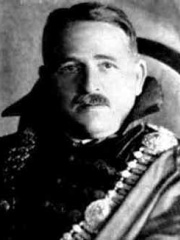
10. Frigyes Riesz (1880 - 1956)
With an HPI of 61.46, Frigyes Riesz is the 10th most famous Hungarian Mathematician. His biography has been translated into 29 different languages.
Frigyes Riesz (Hungarian: Riesz Frigyes, pronounced [ˈriːs ˈfriɟɛʃ], sometimes known in English and French as Frederic Riesz; 22 January 1880 – 28 February 1956) was a Hungarian mathematician who made fundamental contributions to functional analysis, as did his younger brother Marcel Riesz.
People
Pantheon has 24 people classified as Hungarian mathematicians born between 1878 and 1948. Of these 24, 3 (12.50%) of them are still alive today. The most famous living Hungarian mathematicians include László Lovász, Endre Szemerédi, and Béla Bollobás. The most famous deceased Hungarian mathematicians include John von Neumann, Paul Erdős, and John G. Kemeny.
Living Hungarian Mathematicians
Go to all RankingsLászló Lovász
1948 - Present
HPI: 62.77
Endre Szemerédi
1940 - Present
HPI: 60.22
Béla Bollobás
1943 - Present
HPI: 51.49
Deceased Hungarian Mathematicians
Go to all RankingsJohn von Neumann
1903 - 1957
HPI: 79.93
Paul Erdős
1913 - 1996
HPI: 72.17
John G. Kemeny
1926 - 1992
HPI: 69.16
George Pólya
1887 - 1985
HPI: 69.06
Peter Lax
1926 - 2025
HPI: 68.72
Marcel Grossmann
1878 - 1936
HPI: 66.38
Rudolf E. Kálmán
1930 - 2016
HPI: 63.57
Klára Dán von Neumann
1911 - 1963
HPI: 63.48
Frigyes Riesz
1880 - 1956
HPI: 61.46
Paul Halmos
1916 - 2006
HPI: 60.58
Rózsa Péter
1905 - 1977
HPI: 60.06
Pál Turán
1910 - 1976
HPI: 59.53
Overlapping Lives
Which Mathematicians were alive at the same time? This visualization shows the lifespans of the 20 most globally memorable Mathematicians since 1700.

